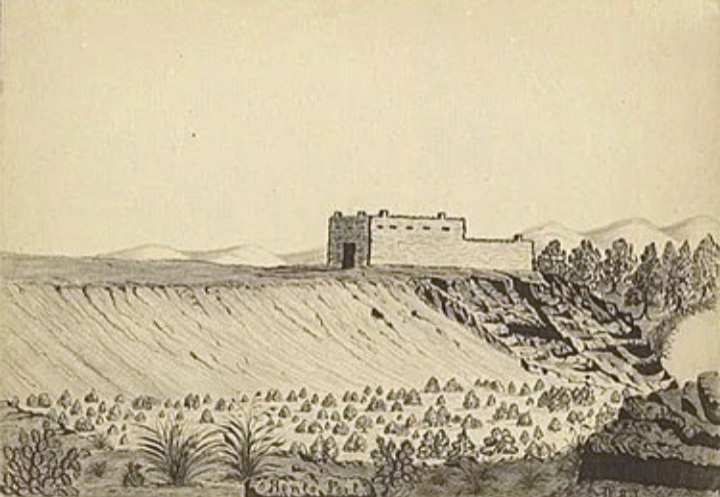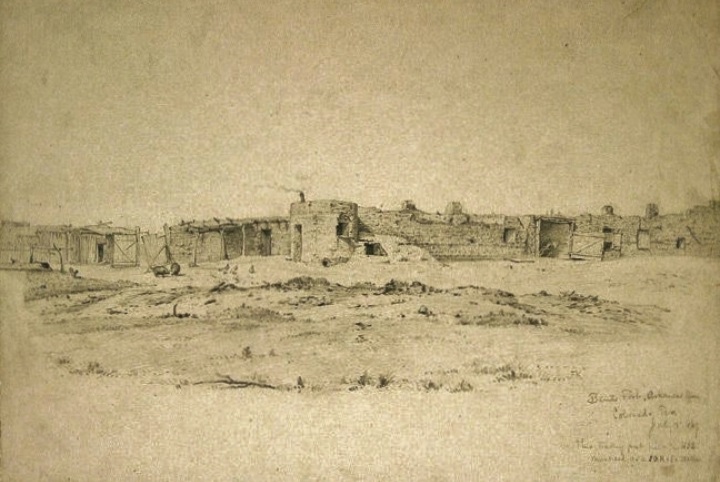BENT BUILDS AND BURNS MASSIVE TRADING POST ON THE SANTA FE TRAIL

Description: Bents New Fort. Daniel Jenks traveled to the Colorado Territory in 1859 in search of gold. While there, he made this sketch of Bents New Fort. *Image courtesy Library of Congress, Prints and Photographs Dept.
Published: 08/18/2021
Byline: Hart

Article by Kellen Cutsforth
BENT BUILDS AND BURNS MASSIVE TRADING POST ON THE SANTA FE TRAIL
 Remains of Bent’s Old Fort as a stagecoach station, sketch dated July 13, 1869. **Image from private collection as reproduced in Bent’s Old Fort Historic Resource Study by Mark L. Gardner.
Remains of Bent’s Old Fort as a stagecoach station, sketch dated July 13, 1869. **Image from private collection as reproduced in Bent’s Old Fort Historic Resource Study by Mark L. Gardner.Opened by Bent, St. Vrain & Company in 1833, Bent's Old Fort became the most prominent spot on the Mountain Branch of the Santa Fe Trail. Until 1849, this huge adobe trading post, looking to some like a castle dropped onto the plains, served tribes, traders, and travelers. William Bent managed the fort; hence it was often known as Fort William over its lifetime.
The fort was always a private, commercial operation. However, during the U.S. war with Mexico, the military used the fort as a supply depot (never compensating the company for this appropriated use). The war also negatively impacted the fort's business. After the war, deaths in his family and a cholera epidemic among the Southern Cheyenne, the fort's main customer base, led William to abandon the post.
As reported in the October 2, 1849, edition of Saint Louis Missouri Republican newspaper, on August 22 an eastbound party that included a Bent employee named Paladay, arrived at Bent’s Fort to find it abandoned and billowing smoke from a large fire. Though we will never know for certain what happened that August, most contemporary accounts agree that William lit the fire, which did not totally destroy the post. The fort later served as a stagecoach stop.
A few years later, in 1853, William constructed a new stone trading post on the Arkansas River at Big Timbers, west of present-day Lamar. This came to be called Bent's New Fort. This post, leased to the U.S. Army in 1860, became part of the original Fort Lyon. From there, in 1864, Col. Chivington and his troops plotted and launched the attack today known as the Sand Creek Massacre. Three of William Bent's children were living in the camp at Sand Creek. Over 230 Cheyenne and Arapaho were killed, but all three Bent offspring survived.
To hear more stories of the Santa Fe Trail attend the two upcoming events in southeast Colorado commemorating the Bicentennial of the Trail: the 2021 Santa Fe Trail Symposium in La Junta, https://www.2021sfts.com/
*Image courtesy Library of Congress, Prints and Photographs Dept.
**Image from private collection as reproduced in Bent’s Old Fort Historic Resource Study by Mark L. Gardner.
Follow SECO News on The Santa Fe Trail: http://seconews.org/santa-fe-trail/
Follow SECO News on Facebook.
Subscribe to the SECO News YouTube Channel.





.png)






.png)
.png)


.png)







